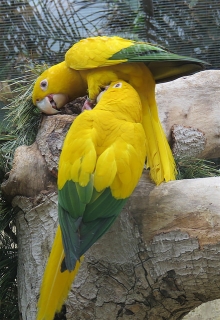Golden Conure |
|
|
Also known as: Queen of Bavaria Conure, Golden Parakeet
Photos
View in GalleryDid You Know?
The Golden Conure will alternate different hollows for roosting on successive nights.Programs & Projects
WPT has worked with numerous partners to help save this species. Learn moreAcademic Research
Related publications: Guaruba guaroubaSpecies Profile
Genus: Guaruba | Species: guarouba
Size:
34 cm (13.3 in)
Weight:
270g (9.5 oz)
Subspecies including nominate:
one
Colour Adult:
Both adults plumage bright yellow, primary, secondary and outer upper wing coverts dark green; yellow tail. Bill horn in colour. Bare, pink/white eye ring, eye brown.
Colour Juvenile:
As in adults but with dark green on cheeks and ear coverts; yellow crown, nape and upperparts, marked with dark green; underparts yellow; breast lightly marked with dull green; uppertail dark green marked yellow. Bill pink. Pale grey, bare eye ring.
Call:
Vibrant, high pitched note given singly or as many as 3-4 per second; during courtship a long strident note. Voice in general softer than Aratinga conures.
Listen NowMore Information:
Content Sources:
CITES
BirdLife International
Cornell Lab of Ornithology/Birds of the World
A Guide to Parrots of the World, Juniper and Parr, 1998
ML Media Collection Catalogue 113073, Golden Parakeet Guaruba guarouba, Marantz, Curtis, Para, Brazil, Sep. 9 1998, Cornell Lab of Ornithology. Site
Parrots: Status Survey and Conservation Plan 2000-2004, Snyder, McGowan, Gilardi and Grajal, 2000.
Vanished and Vanishing Parrots, Forshaw 2017.
Parrots of the World, Forshaw, 2006.
Parrots in Aviculture, Low, 1992.
Psittacine Aviculture, Schubot, Clubb and Clubb, 1992.
Photos
View in GalleryDid You Know?
The Golden Conure will alternate different hollows for roosting on successive nights.Programs & Projects
WPT has worked with numerous partners to help save this species. Learn moreAcademic Research
Related publications: Guaruba guaroubaSpecies Care
Captive Status:
Rare
Longevity:
15-30 yrs
Housing:
Aviary or suspended cage, minimum length 3m (9.8 ft).
Diet:
Cooked beans and pulses, boiled corn, sunflower seed - dry, soaked or sprouted, fruit such as: apple, orange, bananas, pomegranate, cactus fruits; vegetables such as: carrot, celery, green beans and peas in the pod; complete kibble; spray millet.
Enrichment:
Provide overhead misters or shallow water bowls for bathing; foot toys, destructible (non-toxic) toys, non-destructible (non-toxic plastic) toys, food-finder toys, preening toys, different texture and size hanging perch toys; bird-safe, unsprayed flowering, fir, elder, pine or willow branches, push-and-pull toys (sliding up and down), vegetable tanned leather toys.
Nest Box Size:
12" x 12" x 18" (30.5cm x 30.5cm x 46cm) box, or 12" x 12" x 24" (30.5cm x 30.5cm x 61cm) box.
Clutch Size:
2 to 4
Incubation Time:
26 days
Fledging Age:
10 weeks
Hatch Weight:
7-11g (0.2-0.4 oz)
Peak Weight:
154-300g (5.4-10.5 oz)
Weaning Weight:
196-235g (6.9-8.2 oz)
Photos
View in GalleryDid You Know?
The Golden Conure will alternate different hollows for roosting on successive nights.Programs & Projects
WPT has worked with numerous partners to help save this species. Learn moreAcademic Research
Related publications: Guaruba guaroubaSpecies Wild Status
World Population:
10,000-20,000
IUCN Red List Status:
Vulnerable
CITES Listing:
Appendix I
Threat Summary:
Affected by habitat loss at about 30% over some decades which is projected to increase, and by trapping, persecution and hunting. In eastern Pará, the species is heavily trapped and birds are kept as pets locally or sold to illegal traders for resale in major cities.
Range:
N Brazil, where scattered populations are found south from the Amazon river to between the Rio Tapajós, western Pará and Rio Turiacu, western Maranhāo and the upper Rio Madeira and tributaries. Also northern Rondônia and NW Mato Grosso.
Habitat:
Seen in humid lowland rainforest up to 500m (1640 ft), with occasional forays into varzéa forest. Also frequents grasslands with scattered trees.
Wild Diet:
Birds feed on fruits of Açai, seeds of Byrsonima, nuts, berries, buds and flowers. Bertholletia excela, Oenocarpus sp. palms, Symphonia sp. buds, Anacardium spp., Protium and Tetragastris, nectar of Leguminoseae.
Ecology and Behaviour:
Is somewhat nomadic; will wander into different habitats post-breeding. Gregarious at all times of year, roosting and foraging in groups of 3-30 birds. Feeds quietly, mostly unseen, in the dense foliage of the canopy.
Clutch and Egg Size:
2 to 4, round to oval shaped, 34 x 29 mm (1.3 x 1.1 in).
Breeding Season:
November-February. Likely breeds communally with several females contributing to one large clutch with multiple attendants. Nest is in hollow in high, isolated tree.
Related Links:
Photos
View in GalleryDid You Know?
The Golden Conure will alternate different hollows for roosting on successive nights.Programs & Projects
WPT has worked with numerous partners to help save this species. Learn moreAcademic Research
Related publications: Guaruba guaroubaMembers Only Resources
Please log-in now to find more research, resources and tools.
Not a Member?
Find more great information:
Gain exclusive access to 600+ pages of additional research, seminars and podcasts, specialists to ask your toughest questions, and dozens of other fun resources - when you become a WPT member.
Join Today >>

































